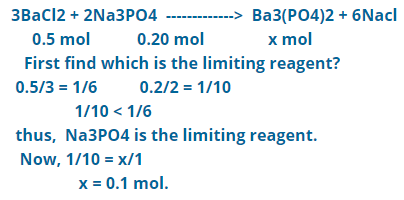Chemistry Exam > Chemistry Questions > If 0.5 mol of BaCl2is mixed with 0.20 mol of ...
Start Learning for Free
If 0.5 mol of BaCl2 is mixed with 0.20 mol of Na3PO4, the maximum amount of Ba3(PO4)2 that can be formed is
- a)0.7
- b)0.5
- c)0.2
- d)0.1
Correct answer is option 'D'. Can you explain this answer?
Verified Answer
If 0.5 mol of BaCl2is mixed with 0.20 mol of Na3PO4, the maximum amoun...

Most Upvoted Answer
If 0.5 mol of BaCl2is mixed with 0.20 mol of Na3PO4, the maximum amoun...
3BaCl2 + 2Na3PO4 -------------> Ba3(PO4)2 + 6Nacl
0.5 mol 0.20 mol x mol
First find which is the limiting reagent?
0.5/3 = 1/6 0.2/2 = 1/10
1/10 < />
thus, Na3PO4 is the limiting reagent.
Now, 1/10 = x/1
x = 0.1 mol.
0.5 mol 0.20 mol x mol
First find which is the limiting reagent?
0.5/3 = 1/6 0.2/2 = 1/10
1/10 < />
thus, Na3PO4 is the limiting reagent.
Now, 1/10 = x/1
x = 0.1 mol.
Free Test
FREE
| Start Free Test |
Community Answer
If 0.5 mol of BaCl2is mixed with 0.20 mol of Na3PO4, the maximum amoun...
Solution:
To find the maximum amount of Ba3(PO4)2 that can be formed, we need to determine the limiting reagent in the reaction between BaCl2 and Na3PO4.
The balanced equation for the reaction is:
3BaCl2 + 2Na3PO4 → Ba3(PO4)2 + 6NaCl
From the equation, we can see that the stoichiometric ratio between BaCl2 and Ba3(PO4)2 is 3:1. This means that for every 3 moles of BaCl2, 1 mole of Ba3(PO4)2 is formed.
Given that we have 0.5 mol of BaCl2 and 0.20 mol of Na3PO4, we can calculate the number of moles of Ba3(PO4)2 that can be formed using the limiting reagent.
1. Find the moles of Ba3(PO4)2 from BaCl2:
Moles of Ba3(PO4)2 = (0.5 mol BaCl2) × (1 mol Ba3(PO4)2 / 3 mol BaCl2)
= 0.1667 mol Ba3(PO4)2
2. Find the moles of Ba3(PO4)2 from Na3PO4:
Moles of Ba3(PO4)2 = (0.20 mol Na3PO4) × (1 mol Ba3(PO4)2 / 2 mol Na3PO4)
= 0.10 mol Ba3(PO4)2
Comparing the moles of Ba3(PO4)2 obtained from BaCl2 and Na3PO4, we can see that the smaller value is 0.10 mol. Therefore, the maximum amount of Ba3(PO4)2 that can be formed is 0.10 mol.
Hence, the correct answer is option D) 0.1.
To find the maximum amount of Ba3(PO4)2 that can be formed, we need to determine the limiting reagent in the reaction between BaCl2 and Na3PO4.
The balanced equation for the reaction is:
3BaCl2 + 2Na3PO4 → Ba3(PO4)2 + 6NaCl
From the equation, we can see that the stoichiometric ratio between BaCl2 and Ba3(PO4)2 is 3:1. This means that for every 3 moles of BaCl2, 1 mole of Ba3(PO4)2 is formed.
Given that we have 0.5 mol of BaCl2 and 0.20 mol of Na3PO4, we can calculate the number of moles of Ba3(PO4)2 that can be formed using the limiting reagent.
1. Find the moles of Ba3(PO4)2 from BaCl2:
Moles of Ba3(PO4)2 = (0.5 mol BaCl2) × (1 mol Ba3(PO4)2 / 3 mol BaCl2)
= 0.1667 mol Ba3(PO4)2
2. Find the moles of Ba3(PO4)2 from Na3PO4:
Moles of Ba3(PO4)2 = (0.20 mol Na3PO4) × (1 mol Ba3(PO4)2 / 2 mol Na3PO4)
= 0.10 mol Ba3(PO4)2
Comparing the moles of Ba3(PO4)2 obtained from BaCl2 and Na3PO4, we can see that the smaller value is 0.10 mol. Therefore, the maximum amount of Ba3(PO4)2 that can be formed is 0.10 mol.
Hence, the correct answer is option D) 0.1.

|
Explore Courses for Chemistry exam
|

|
Question Description
If 0.5 mol of BaCl2is mixed with 0.20 mol of Na3PO4, the maximum amount of Ba3(PO4)2that can be formed isa)0.7b)0.5c)0.2d)0.1Correct answer is option 'D'. Can you explain this answer? for Chemistry 2025 is part of Chemistry preparation. The Question and answers have been prepared according to the Chemistry exam syllabus. Information about If 0.5 mol of BaCl2is mixed with 0.20 mol of Na3PO4, the maximum amount of Ba3(PO4)2that can be formed isa)0.7b)0.5c)0.2d)0.1Correct answer is option 'D'. Can you explain this answer? covers all topics & solutions for Chemistry 2025 Exam. Find important definitions, questions, meanings, examples, exercises and tests below for If 0.5 mol of BaCl2is mixed with 0.20 mol of Na3PO4, the maximum amount of Ba3(PO4)2that can be formed isa)0.7b)0.5c)0.2d)0.1Correct answer is option 'D'. Can you explain this answer?.
If 0.5 mol of BaCl2is mixed with 0.20 mol of Na3PO4, the maximum amount of Ba3(PO4)2that can be formed isa)0.7b)0.5c)0.2d)0.1Correct answer is option 'D'. Can you explain this answer? for Chemistry 2025 is part of Chemistry preparation. The Question and answers have been prepared according to the Chemistry exam syllabus. Information about If 0.5 mol of BaCl2is mixed with 0.20 mol of Na3PO4, the maximum amount of Ba3(PO4)2that can be formed isa)0.7b)0.5c)0.2d)0.1Correct answer is option 'D'. Can you explain this answer? covers all topics & solutions for Chemistry 2025 Exam. Find important definitions, questions, meanings, examples, exercises and tests below for If 0.5 mol of BaCl2is mixed with 0.20 mol of Na3PO4, the maximum amount of Ba3(PO4)2that can be formed isa)0.7b)0.5c)0.2d)0.1Correct answer is option 'D'. Can you explain this answer?.
Solutions for If 0.5 mol of BaCl2is mixed with 0.20 mol of Na3PO4, the maximum amount of Ba3(PO4)2that can be formed isa)0.7b)0.5c)0.2d)0.1Correct answer is option 'D'. Can you explain this answer? in English & in Hindi are available as part of our courses for Chemistry.
Download more important topics, notes, lectures and mock test series for Chemistry Exam by signing up for free.
Here you can find the meaning of If 0.5 mol of BaCl2is mixed with 0.20 mol of Na3PO4, the maximum amount of Ba3(PO4)2that can be formed isa)0.7b)0.5c)0.2d)0.1Correct answer is option 'D'. Can you explain this answer? defined & explained in the simplest way possible. Besides giving the explanation of
If 0.5 mol of BaCl2is mixed with 0.20 mol of Na3PO4, the maximum amount of Ba3(PO4)2that can be formed isa)0.7b)0.5c)0.2d)0.1Correct answer is option 'D'. Can you explain this answer?, a detailed solution for If 0.5 mol of BaCl2is mixed with 0.20 mol of Na3PO4, the maximum amount of Ba3(PO4)2that can be formed isa)0.7b)0.5c)0.2d)0.1Correct answer is option 'D'. Can you explain this answer? has been provided alongside types of If 0.5 mol of BaCl2is mixed with 0.20 mol of Na3PO4, the maximum amount of Ba3(PO4)2that can be formed isa)0.7b)0.5c)0.2d)0.1Correct answer is option 'D'. Can you explain this answer? theory, EduRev gives you an
ample number of questions to practice If 0.5 mol of BaCl2is mixed with 0.20 mol of Na3PO4, the maximum amount of Ba3(PO4)2that can be formed isa)0.7b)0.5c)0.2d)0.1Correct answer is option 'D'. Can you explain this answer? tests, examples and also practice Chemistry tests.

|
Explore Courses for Chemistry exam
|

|
Signup for Free!
Signup to see your scores go up within 7 days! Learn & Practice with 1000+ FREE Notes, Videos & Tests.























